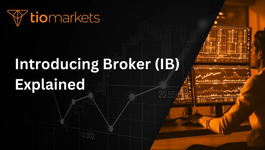Order Book: Explained
BY TIOmarkets
|August 12, 2024The order book is an essential tool for traders, providing a real-time snapshot of the market's demand and supply for a specific security. It's a dynamic, ever-changing record of buy and sell orders for a particular financial instrument, such as a stock, bond, or currency pair. The order book provides critical information about the price levels at which traders are willing to buy and sell, the size of these orders, and the sequence in which they were placed.
Understanding the order book can give traders a significant edge, helping them to anticipate price movements and make more informed trading decisions. This glossary entry will delve into the intricacies of the order book, explaining its structure, functions, and how traders can use it to their advantage.
Structure of the Order Book
The order book is composed of two main sections: the bid side and the ask side. The bid side lists all the buy orders, with the highest bid price (the maximum price a buyer is willing to pay) at the top. The ask side, on the other hand, lists all the sell orders, with the lowest ask price (the minimum price a seller is willing to accept) at the top. This structure allows traders to quickly identify the best available prices for buying or selling a security.
Each entry in the order book includes the price of the order, the size of the order (the number of shares or contracts), and the time the order was placed. Some order books also include information about the market participant who placed the order, although this is less common in retail trading platforms.
Price Levels
Price levels in the order book represent the different prices at which traders are willing to buy or sell a security. Each price level corresponds to a group of buy or sell orders at the same price. The number of price levels in an order book can vary widely, depending on the liquidity and volatility of the security.
The highest price level on the bid side and the lowest price level on the ask side form what's known as the bid-ask spread. This spread is a key indicator of the market's liquidity and the cost of trading. A narrow spread indicates high liquidity and low trading costs, while a wide spread suggests the opposite.
Order Size
The size of an order refers to the number of shares or contracts that a trader wants to buy or sell. In the order book, the size of each order is listed next to the price. The cumulative size of all orders at a particular price level is often displayed as well, giving traders a sense of the depth of the market at that price.
Large orders can have a significant impact on the price of a security. For example, a large buy order can push the price up, while a large sell order can drive the price down. Traders often look at the size of the orders in the order book to gauge the potential impact of these orders on the market.
Types of Orders
The order book contains different types of orders, each with its own characteristics and implications for trading. The most common types are market orders, limit orders, and stop orders.
Market orders are orders to buy or sell a security at the best available price. They are executed immediately and are guaranteed to fill, but the execution price is not guaranteed. Limit orders, on the other hand, are orders to buy or sell a security at a specific price or better. They offer price guarantee but not execution guarantee. Stop orders are orders to buy or sell a security once it reaches a certain price, known as the stop price. When the stop price is reached, the stop order becomes a market order and is executed at the best available price.
Market Orders
Market orders are the simplest type of order. When a trader places a market order, they are essentially saying, "I want to buy or sell this security right now, regardless of the price." Because of their immediacy, market orders are often used when speed is more important than price.
However, market orders come with a risk: the risk of slippage. Slippage occurs when the execution price of a market order is different from the expected price. This can happen when the market is moving quickly or when there's not enough liquidity at the best bid or ask price to fill the order. Traders need to be aware of this risk when using market orders, especially in volatile markets.
Limit Orders
Limit orders are orders to buy or sell a security at a specific price or better. When a trader places a limit order, they are saying, "I want to buy or sell this security, but only at this price or a better one." This gives the trader more control over the execution price, but at the cost of potentially not getting the order filled.
Limit orders are displayed in the order book until they are filled or cancelled. The placement of limit orders in the order book can influence the price of the security, as they add to the supply and demand at different price levels. Traders often use limit orders to manage their risk, set their profit targets, and avoid buying or selling at unfavorable prices.
Using the Order Book for Trading
The order book can be a powerful tool for trading, providing insights into the market's supply and demand, price levels, and potential price movements. By analyzing the order book, traders can make more informed decisions and improve their trading performance.
However, using the order book effectively requires skill and experience. It's not just about reading the numbers; it's about understanding what they mean and how they can affect the market. Here are some ways traders use the order book for trading.
Identifying Support and Resistance Levels
Support and resistance levels are key concepts in technical analysis. They represent price levels at which the price of a security tends to stop and reverse. These levels are often associated with significant buying or selling activity.
In the order book, support levels can be identified by looking for price levels with a large number of buy orders. These levels represent prices at which a lot of traders are willing to buy the security, potentially stopping the price from falling further. Resistance levels, on the other hand, can be identified by looking for price levels with a large number of sell orders. These levels represent prices at which a lot of traders are willing to sell the security, potentially stopping the price from rising further.
Gauging Market Sentiment
The order book can also be used to gauge market sentiment, or the overall attitude of traders towards a security. By looking at the size and distribution of the orders in the order book, traders can get a sense of whether the market sentiment is bullish (favoring upward price movements) or bearish (favoring downward price movements).
For example, if the order book shows a large number of buy orders at higher prices, this could indicate bullish sentiment, as it suggests that traders are willing to buy the security at higher prices. Conversely, if the order book shows a large number of sell orders at lower prices, this could indicate bearish sentiment, as it suggests that traders are willing to sell the security at lower prices.
Limitations of the Order Book
While the order book can provide valuable insights into the market, it also has its limitations. One of the main limitations is that it only shows a part of the market's total order flow. Many orders, especially large ones, are not displayed in the order book to avoid influencing the market. This is known as hidden or iceberg orders.
Another limitation is that the order book is a snapshot of the market at a specific point in time. It can change rapidly, especially in volatile markets, making it difficult to use for long-term trading strategies. Furthermore, the order book does not provide any information about the intentions or motivations of the traders placing the orders, which can be a critical factor in understanding market behavior.
Hidden Orders
Hidden orders, also known as iceberg orders, are orders that are not fully displayed in the order book. Only a portion of the order, known as the tip, is visible to other market participants. The rest of the order, the iceberg, is hidden.
Traders use hidden orders to avoid revealing their trading intentions and influencing the market. For example, a trader who wants to buy a large amount of a security might use a hidden order to avoid driving the price up. However, hidden orders can also make the order book less transparent and more difficult to interpret.
High-Frequency Trading
High-frequency trading (HFT) is a type of algorithmic trading that involves making a large number of trades in a very short period of time, often milliseconds or microseconds. HFT firms use sophisticated algorithms and high-speed data networks to analyze the order book and execute trades faster than human traders.
While HFT can provide liquidity and reduce spreads, it can also create challenges for traditional traders. HFT firms can react to changes in the order book faster than human traders, potentially leading to situations where the order book does not accurately reflect the market's supply and demand. Furthermore, HFT can increase market volatility and contribute to flash crashes, where the price of a security drops rapidly and then recovers just as quickly.
Conclusion
The order book is a vital tool for traders, offering a real-time view of the market's supply and demand for a particular security. Understanding the order book can help traders anticipate price movements, identify trading opportunities, and make more informed trading decisions. However, using the order book effectively requires skill, experience, and an understanding of its limitations.
Whether you're a novice trader just starting out or an experienced trader looking to refine your strategies, the order book can be a valuable resource. By taking the time to understand the order book and how to use it, you can gain a deeper understanding of the market and improve your trading performance.
Start Trading with Confidence at TIOmarkets
Now that you understand the importance of the order book in trading, take the next step with TIOmarkets. As a top rated forex broker, we offer a robust online trading platform where you can trade over 300 instruments across Forex, indices, stocks, commodities, and futures markets. Join our community of 170,000+ traders in over 170 countries and benefit from low fees and a wealth of educational resources to refine your trading skills. Ready to dive into the market with an edge? Create a Trading Account today and start trading with the insight and confidence you need to succeed.

Risk disclaimer: CFDs are complex instruments and come with a high risk of losing money rapidly due to leverage. You should consider whether you understand how CFDs work and whether you can afford to take the high risk of losing your money. Never deposit more than you are prepared to lose. Professional client’s losses can exceed their deposit. Please see our risk warning policy and seek independent professional advice if you do not fully understand. This information is not directed or intended for distribution to or use by residents of certain countries/jurisdictions including, but not limited to, USA & OFAC. The Company holds the right to alter the aforementioned list of countries at its own discretion.
Join us on social media

Behind every blog post lies the combined experience of the people working at TIOmarkets. We are a team of dedicated industry professionals and financial markets enthusiasts committed to providing you with trading education and financial markets commentary. Our goal is to help empower you with the knowledge you need to trade in the markets effectively.





